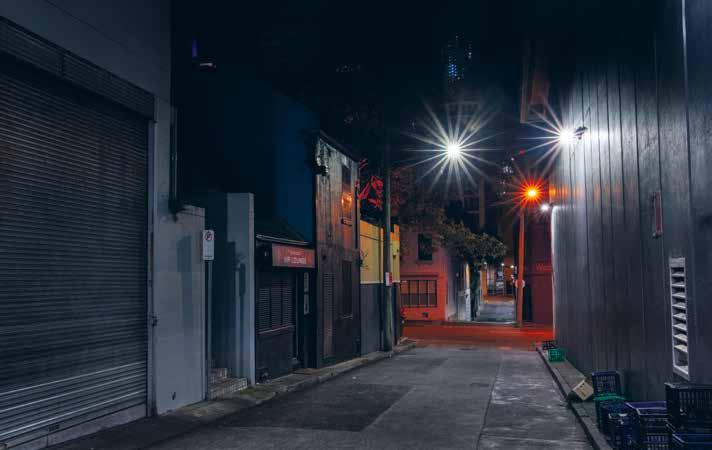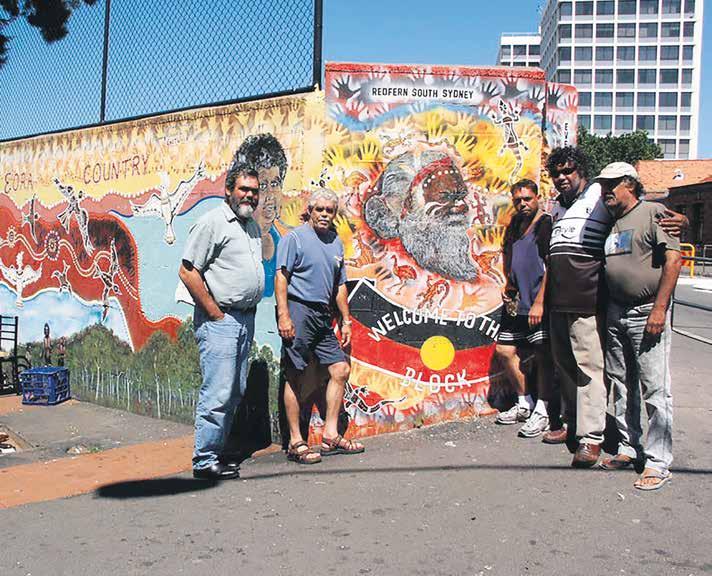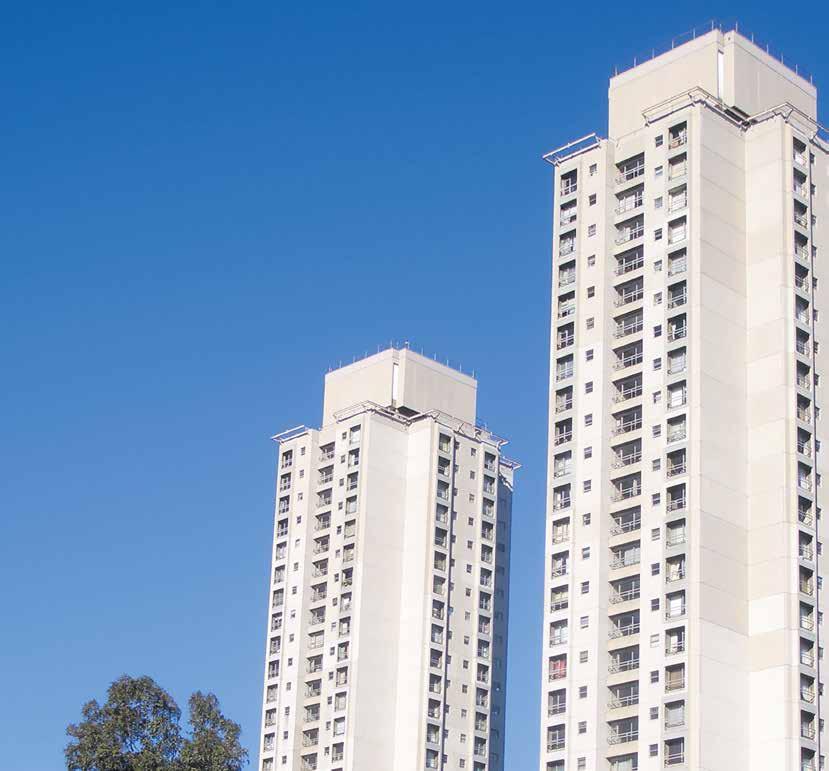
13 minute read
News
l CLEAN ENERGY
Running on renewables
Advertisement
From the 1 July, the City of Sydney officially became powered by 100 percent renewable energy. The council — which covers the CBD and more than 30 surrounding inner-city suburbs — is now sourcing the equivalent of all its electricity consumption from renewa ble supplies obtained from two solar farms and one wind farm. Based near Inverell, the wind farm is the largest in NSW. It features 75 turbines up to 200 metres high and carries a capacity of 270MW. par Almost three-quarters of the City’s electricity is wind-gen erated and clean energy now powers The design looks impressive: an 180-metre timber high-rise fronting a glass and steel facade, solar panels scaling its sides, with a staggered rooftop garden crowning the structure up above. When completed in 2025, the new headquarters for Australian soft ware firm Atlassian will be the tallest hybrid timber tower in the world.
While designing the building, the New York-based architects’ watch word was sustainability. To that end, the building will operate on 100 percent renewable energy (netting zero emissions by 2050) and use cross-laminated timber. Which is, says Atlassian’s Scott Hazard, “an incredibly green material” that avoids “massive amounts of concrete and steel”. The ground-breaking design, adds Hazard, will push the boundaries “beyond anything we know with that material”.
Once favoured by conceptual design ers, over recent years cross-laminated timber (CLT) has entered the mainstream of construction and has become the go-to product for devel opers around the world. Not only is the material strong, CLT buildings all City-owned properties, including 115 buildings, 75 parks, 23,000 street lights, depots, pools, and sporting facilities. In making the move to renewable electricity, the council is projected to reduce C02 emissions by 20,000 tonnes per year and save halfa-million dollars on energy costs over the next decade. “Cities are responsi ble for 70 percent of greenhouse gas emissions worldwide, so it is critical that we take effective and evidencebased climate actions,” said Sydney lord mayor, Clover Moore. Valued at $60 million, the City’s green energy are quicker to construct which, in turn, saves time and labour. It also carries much less of an environmental burden than concrete. Indeed, rather deal is the biggest of its kind in Australia.
Certified carbon neutral in 2011, the City is on target to reduce C02 emis sions by 70 percent by 2024. “We are in the middle of a climate emergency,” said Moore. “If we are to reduce emis sions and grow the green power sector, all levels of government must urgently transition to renewable energy.” The City of Sydney joins other Australian jurisdictions that have transitioned to renewable energy supplies including the City of Adelaide, City of Newcastle,
l SUSTAINABLE CONSTRUCTION
Sydney’s plyscraper plans
and Canberra. than emitting carbon, CLT has carbon locked in.
Sitting next to Sydney’s Central station, the $1-billion building will be the focal point of the city’s new tech precinct — which will sprawl from Haymarket to Redfern. “It’s an amazing design,” says Atlassian co-CEO Scott Farquhar. “This build ing will breathe new life into this part of Sydney.” Construction starts next year.
Meanwhile, plans have been submit ted to build 80-storey twin towers in Sydney’s CBD. At a cost of $726 million, the Pitt Street development will house 158 hotel rooms, 600 apartments and five levels of carparks. The two towers are to be linked by a sky-bridge.
Whilst the development will require the demolition of existing buildings on Pitt, Castlereagh and Liverpool streets, assurances have been made that no “heritage-listed” buildings will be affected. However, construc tion will “have the potential to cause disruption to surrounding areas”. A City of Sydney spokesperson said the development application would be considered at a meeting later this year.
NEWS
l INNER SYDNEY DEVELOPMENT
Waterloo South details released
Since the Land and Housing Corporation (LAHC) released the Waterloo South artist impressions, City of Sydney has released further details. A map with building heights compares LAHC’s current proposal with its 2019 preferred plan and council’s alternative proposal. (A detailed presentation is now also available as a webinar on council’s website.) Officers expect to present their planning proposal and the 10,000 pages of LAHC material they have considered, to council around November 2020. Some material is promised before then.
Council distinguishes between the planning framework (the controls that they have to determine) and the refer ence scheme (masterplan) supplied by LAHC as a test of the framework. The reference scheme’s artist impressions are just one of many outcomes possible under the controls. Once determined, the controls will provide the frame work for the developer to produce its designs to be assessed and exhibited at a later stage.
In the webinar, council details “improvements” LAHC made to its 2019 preferred masterplan, includ ing: the large central park opposite the new metro station; more sunlight in parks; George Street remaining a street; no development over existing streets; some streets widened; build ing heights reduced to meet Sydney airport requirements, and regional bicycle path retained (but back to being a “shared path” running between the towers whose elderly residents had convinced LAHC to reroute via the metro station for safety reasons).
Eddie Ma from Vigilanti says the new park is the same size as the existing open space on the estate, but will need to service many more people. Council emphasises the new park is not privately owned and becomes public space.
Heights and density are two concerns for community. LAHC proposes around 3,000 dwellings in nine towers of between 20 and 32 storeys, three build
Image: communitiesplus.com.au
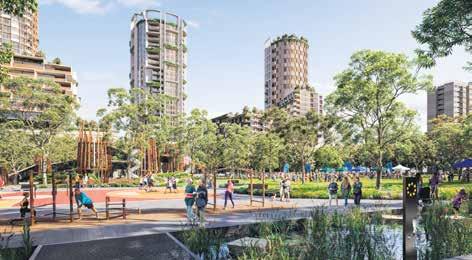
ings of 15 storeys and a range of other buildings up to eight storeys high. On its website, council has made it clear that “it is likely changes will be made to the proposal the corporation has submitted”. Eddie Ma points out that the highest building in Green Square is 28 storeys.
LAHC proposes one 32-storey build ing with 10.55 times more floor space than its land area. Council says this is “typical of floor space ratios (FSR) in the centre of the city and rarely found outside the city centre”.
The FSR proposed across the total site is 3.09:1, which is what LAHC proposes for privately owned sites. LAHC gets greater FSRs on its land by adding the floor space it could have built on the 40 percent of the site it is giving council for parks and streets. LAHC also proposes its floor space not be spread evenly so a private block might have only 29 percent of the development potential of a nearby LAHC tower.
Discussions are underway about how council can best help people understand the proposal and consult the commu nity during the public exhibition in the first half of 2021. Council’s webinar is an excellent start — just search for “City of Sydney Waterloo”.
Geoff Turnbull — courtesy The South Sydney Herald
l PUBLIC TRANSPORT Next stage of station work begins
With tunnelling and excavation work completed at Waterloo station, work has now begun on the integrated station development — including buildings above and next to the station.
John Holland is currently carrying out works in preparation for station construction. This includes delivery and installation of site sheds, surveys and utility relocations. Another contractor — Systems Connect — is also using the Waterloo site to install rail track, power systems and infrastructure to turn the excavated tunnels into a working railway. While the work is in progress, traffic and pedestrian changes may be required for large vehicle deliveries.
If members of the Waterloo community have questions about the tunnel fit-out they can call 1800 171 386 or email linewidemetro@transport.nsw.gov. au. For questions about Waterloo station or the Waterloo Metro Quarter resi dents can call 1800 171 386 or email waterloometro@transport.nsw.gov.au.
NEWS
l PUBLIC TRANSPORT
Concerns over concourse
The University of Sydney has lodged a formal objection to the proposal for a new southern concourse at Redfern station. In a submission to the Depart ment of Planning, Industry and the Environment, vice-chancellor Michael Spencer voiced concerns about student safety due to potential pedestrian congestion on Little Eveleigh Street.
The university also opposes proposed plans for gated pedestrian bridges either end of the concourse. As currently designed — whether using the station or not — people crossing from one precinct to another will have l COVID-19 More than 200,000 jobs in the charity sector could be lost as a result of the COVID-19 crisis if financial supports — such as JobKeeper, and lease and loan deferrals — come to an end in October. That’s the outcome of a report released by Social Ventures Australia (SVA) and the Centre for Social Impact (CSI).
Due to pre-existing funding issues, an increasing demand for services during the COVID-19 pandemic and subsequent economic downturn, char ities are facing an increase in delivery costs and struggling to secure funding to adapt to this new environment.
SVA chief executive officer Suzie Riddell said that we must act on these dire forecasts to ensure communities, people and governments continue to receive life-changing support and services. “Our financial analysis shows that thousands of charities are at risk of closing and more than 200,000 jobs lost at a time when we should be pump-priming charities to aid the recovery.” Riddell added: “Charities provide services that people, commu nities and government rely on. They are the social glue in our communities. Without thriving charities, our produc tivity and wellbeing is at risk.”
CSI chief executive Professor Kristy Muir said that most charities already run with very tight margins and have little in reserve to fall back on in a crisis. “For Australia to thrive, charities need financially viable business models (not just revenue growth) in the recovery phase and into the future. Stronger charities will be well-positioned to provide the services needed to support the community and assist to accelerate our collective recovery. This impending crisis of an ‘October cliff’ could disrupt the provision of services to some of Australia’s most vulnerable.”
The report calls for governments to ensure resilience and viability of the charity sector through a range of supports, including: • Plan for a gradual transition of
JobKeeper and other temporary supports for charities to create a ramp not a cliff in October, including temporary extensions of funding in sub-sectors facing long recovery times. • Create a one-off Charities Transfor mation Fund to help organisations transition to the “new normal”,
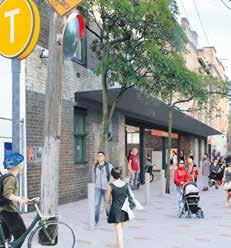
Image: Transport NSW to go through the gates and a ticketing process.
“We seek open access to the bridge for pedestrians as a key facilitator of connection and collaboration between the university, Cicada and South Eveleigh, and the future Waterloo station,” said Spencer. As plans stand, the ticketed gates would be closed between 1.45am and 3.45am.
Transport for NSW is currently in the process of formalising a response to community submissions. A report addressing issues and concerns will be
Charities face dire financial future
made public in the months ahead.
including operating online, restruc turing their organisation and investing in the capability of staff. • Maintain and, where needed, increase funding for govern ment-contracted services delivered by charities to reflect the true cost of delivering services for impact and meeting increased demand, particularly given the sensitivity of the sector to changes in government funding. • Retain JobSeeker at a higher level (do not revert to previous Newstart amounts) to mitigate the increase in service demand on charities while also stimulating the broader economy.
CEO of the Australian Council of Social Service Cassandra Goldie echoed the need for ongoing support: “The community sector is vital at all times but especially in crisis. Community sector charities must have the resources required to meet the increased demand for their important services, including domestic violence and homelessness services. We must ensure those reach ing out for the support of community service charities get the help they need to rebuild their lives.” (See page 12.)
NEWS
l URBAN TREE CANOPY
The Inner West “tree massacre”
A change to tree-clearing rules in the Inner West has triggered a “tree massacre” — according to Balmain Greens MP Jamie Parker. The rule change, which came into effect in February, allows landowners to chop down trees within two metres of a household structure — the limit was previously three metres.
“The tree massacre we predicted is well and truly under way,” said Parker. “In a highly dense area like the Inner West, allowing the removal of any tree within two metres of a structure pretty much allows the destruction of the vast majority of trees in our community.”
Records show that between Febru ary to the end of June the Inner West Council received 429 tree-clearing applications, compared to 240 in the same period last year. Of the 2020 applications 275 have been approved,
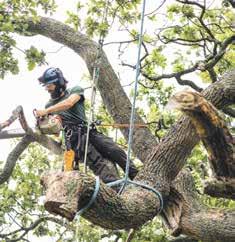
with another 82 applications pending.
In response, Inner West mayor Darcy Byrne pointed to council plans to spend $5 million on new tree plant ings. “That’s an eight-fold increase in funding for tree planting, and the biggest investment in green infra structure in the history of the Inner Plans for an AIDS memorial in Darlinghurst have moved to stage two with shortlisted artists pitching their proposals to the City of Sydney. The idea for the memorial — to be situated at Green Park — received bipartisan support when put forward to coun cil earlier this year. “While we may not agree on everything I think it is wonderful that there is support across the board for our LGBTQ+ community and for a painful moment in Sydney’s history,” said deputy mayor Jess Scully — who proposed the motion.
The concept originated from Darling hurst resident Mike Galvin who teamed up with local artist Christopher Lewis to petition for the memorial. “It wasn’t just the LGBTQ+ community that supported it,” Galvin told City Hub, “but also local families that wanted their children to grow up to understand the West,” said Byrne.
However, Jeff Angel of the Total Environment Centre (TEC), said the mature trees being removed in the Inner West “will lead to a big net loss in suburbs already with poor canopy cover”. And, argues Angel, during COVID-19 Sydney’s green spaces are more valuable than ever. “But sadly the spread of ill-thought urban devel opment and infrastructure has eroded this vital asset.”
Indeed, over the last few years TEC has recorded more than 70 parks and green canopies destroyed or threat ened. “Dozens of local community groups have mobilised to fend off developers and the weakening of tree protection rules.” Success, however, has been patchy. The answer? “Our tree canopies need stronger legislative protection,” said Angel. “It is virtually
l PUBLIC ART IN SYDNEY AIDS memorial a step closer
Image: City of Sydney Archives
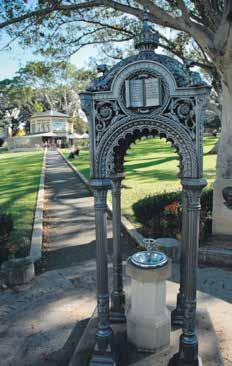
impossible to replace them.” history of the area in the 1980s when AIDS spread unforgivingly through the community, and around the country.”
St Vincent’s Hospital, which is located directly across from Green Park, was home to Australia’s first dedicated AIDS unit — Ward 17 South. During the height of the epidemic, Green Park became a place where many people sought comfort and solace during those dark times.
The remit for the AIDS memorial is wide: it could take the form of a sculp ture, a garden, or even include more ephemeral elements such as light or sound. A City of Sydney spokesperson said: “This is a unique opportunity for artists and creatives to consider the place of public artworks in the public domain, and how they can shape our understanding and collective memory of a time and place.”


